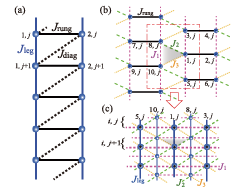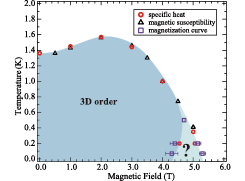Quantum Phase near the Saturation Field in the S=1/2 Frustrated Spin Ladder
H. Yamaguchi and T. Sakakibara
Frustration in spin systems suppresses conventional magnetic orders and induces a variety of exotic quantum phenomena. Much attention has recently been paid to frustrated ferromagnets, in which ferromagnetic (FM) and antiferromagnetic (AFM) interactions strongly compete. In these systems, magnons are expected to form multiple bound states at high magnetic fields near the saturation point, owing to attractive FM interactions. Theoretical works have suggested that correlations between the bound magnons form a spin-multipolar (SM) phase and that a subsequent condensation brings about a hidden order of spin multipoles in various spin systems. Among them, the spin-nematic (quadrupolar) phase has been extensively studied as a possible candidate of the Bose-Einstein condensation of two-magnon bound states, but there is currently no clear experimental evidence of its realization. Regarding the macroscopic behavior, the magnetization curve is predicted to show an anomalous change at the phase transition to the spin-nematic order near the saturation field [1].

Fig. 1. (a) Frustrated spin ladder formed by Jleg, Jrung and the additional Jdiag for 3-I-V. The 3D lattices connected by the interladder interactions J1, J2, and J3 viewed along (b) the leg and (c) the rung directions for 3-I-V. The shadowed plane in each figure shows one of the interladder triangular units, causing frustration.

Fig. 2. Magnetic field vs temperature phase diagram showing the 3D order phase and nontrivial phase near the saturation field. The circles, triangles, and squares indicate the phase boundaries determined from the specific heat, the magnetic susceptibility, and the magnetization curve, respectively.
Here, we report on a low-temperature study of the S=1/2 organic spin ladder 3-I-V [2], which we recently succeeded in synthesizing and reported as a strong-leg spin ladder with FM leg interactions [3]. Ab initio molecular orbital (MO) calculations revealed that the low-temperature spin model in 3-I-V can be regarded as a weakly coupled frustrated spin ladder. Considering the magnetic and thermodynamic properties, we strongly suggest that the observed low-field phase and the phase near the saturation field are, respectively, a longitudinal spin-density-wave (SDW) order and a subsequent SM order like a spin-nematic phase.
The MO calculations indicate four kinds of additional interactions excluding those forming the spin ladder. Considering those additional interactions, we found two types of triangular units inducing frustration through the combination of the signs of the interactions. One combination consists of intraladder interactions Jleg, Jrung, and Jdiag, and the other consists of interladder interactions J1, J2, and J3, as shown in Figs. 1(a)–1(c).
The temperature dependence of the magnetization indicates singular cusp-like extremes [2], originating from the Bose-Einstein condensation of magnons. The specific heats consistently exhibite sharp peaks at the temperatures corresponding to these features [2]. On the other hand, we found a broad peak indicating two phase boundaries in the magnetic field dependence of the specific heat at 0.2 K. We plotted these temperatures in the magnetic field-temperature phase diagram in Fig. 2. The obtained phase diagram suggests a low-field three-dimensional (3D) order and a nontrivial phase near the saturation field. Furthermore, we found nonmonotonic behavior of the field derivative of the magnetization curve (dM/dB) near the saturation field [2], which suggests the existence of an intermediate phase with large quantum fluctuations just below the saturation field, as shown in Fig. 2.
We classified the low-field 3D ordered phase on the basis of the presence or absence of a successive phase transition. There is no successive phase transition in the temperature dependence of the specific heat for 3-I-V, while the corresponding curves for isomorphous 3-Cl-4-F-V and 3-Br-4-F-V indicate successive phase transitions accompanied by distinct double peaks. The absence of a successive phase transition in 3-I-V strongly suggests an SDW order with a single-component order parameter along the field direction. The presence of the SDW phase definitely indicates the formation of multi-magnon bound states [1]. Hence, the SM order is one possible explanation of the nontrivial phase near the saturation field, where the magnetization curve indicates large quantum fluctuations. For 3-I-V, the enhanced frustration effect originating from the FM diagonal interaction is considered to stabilize multi-magnon bound states.
References
- [1] T. Hikihara, L. Kecke, T. Momoi, and A. Furusaki, Phys. Rev. B 78, 144404 (2008)
- [2] H. Yamaguchi, H. Miyagai, Y. Kono, S. Kittaka, T. Sakakibara, K. Iwase, T. Ono, T. Shimokawa, and Y. Hosokoshi, Phys. Rev. B 91, 125104 (2015)
- [3] H. Yamaguchi, H. Miyagai, T. Shimokawa, K. Iwase, T. Ono, Y. Kono, N. Kase, K. Araki, S. Kittaka, T. Sakakibara, T. Kawakami, K. Okunishi, and Y. Hosokoshi, J. Phys. Soc. Jpn. 83, 033707 (2014).
